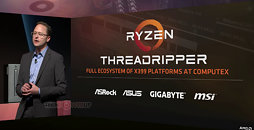Tuesday, May 30th 2017

AMD Ryzen Threadripper Detailed - Why Intel HEDT is in Trouble
AMD today talked a little more about the Ryzen Threadripper, its upcoming line of HEDT (high-end desktop) processors, which will compete with Intel's recently launched Core i7 and Core i9 X-series processors. The chips will still be launched "later this Summer," and AMD hasn't mentioned models, yet. We know of at least two features which will spell trouble for Intel, and it's not the CPU core performance.
The first of two killer Threadripper features is that it has 64 PCI-Express gen 3.0 lanes across all its models - 12-core and 16-core. This is unlike Intel, where you get 44 (not 64) PCIe lanes to begin with, and those start with the $999 Core i9-7900X ten-core processor. Models below this are relegated to 28 lanes, removing the biggest advantage of the HEDT platform - to be able to run more than one graphics card at full x16 PCIe bandwidth. The second killer Threadripper feature is its memory controller. AMD announced that Quad-channel DDR4 memory will be available across the lineup. This again is unlike Intel, where the Core i5-7640X and Core i7-7740X quad-core LGA2066 chips feature just dual-channel memory. All Threadripper chips further feature 32 MB of shared L3 cache. ASUS, ASRock, GIGABYTE, and MSI are said to be developing Ryzen Threadripper motherboards based on the X399 chipset as we speak.
The first of two killer Threadripper features is that it has 64 PCI-Express gen 3.0 lanes across all its models - 12-core and 16-core. This is unlike Intel, where you get 44 (not 64) PCIe lanes to begin with, and those start with the $999 Core i9-7900X ten-core processor. Models below this are relegated to 28 lanes, removing the biggest advantage of the HEDT platform - to be able to run more than one graphics card at full x16 PCIe bandwidth. The second killer Threadripper feature is its memory controller. AMD announced that Quad-channel DDR4 memory will be available across the lineup. This again is unlike Intel, where the Core i5-7640X and Core i7-7740X quad-core LGA2066 chips feature just dual-channel memory. All Threadripper chips further feature 32 MB of shared L3 cache. ASUS, ASRock, GIGABYTE, and MSI are said to be developing Ryzen Threadripper motherboards based on the X399 chipset as we speak.





90 Comments on AMD Ryzen Threadripper Detailed - Why Intel HEDT is in Trouble
5. Increase IPC and lower clock speed (Palomino).
They're all reasonable actions in various circumstances. Hell, you may even lower both if that allows for a killer price.
So, that aside, you are talking about something that cant be released right now..and is likely not even taped out. This is more than throwing a bone, being that far away...
Now maybe with AMD back in the game Intel will actually put out something decent but I'm not holding my breath.
What you need to realize is x86 is almost 40 years old. x86_64 is almost 15. The architecture has been optimized again and again. I doubt there's much left to squeeze out of it.
All improvements we see today are all because more transistors are shoved onto a CPU, not because significant pipeline redesigns. And even shoving more transistors becomes increasingly more difficult.
Yes, I'm 100% sure Intel has been slacking as a result of AMD lagging behind, but at the same time, I'm 95% sure the x86 days you're talking about are over.
www.google.com/search?q=ryzen+die+yields&oq=ryzen+die+yields&aqs=chrome..69i57.8214j0j4&client=ms-android-verizon&sourceid=chrome-mobile&ie=UTF-8
99.9% also seems incredibly unrealistic for these complex dies anyway...
That is what I thought, but apparently the lower power light used during production on the mask is getting better yields as it has a cleaner result than Intel which seem to have issues with edge deterioration from higher power or intensity light damaging the mask or resist layer.
An example of this is Firefox, it's compiled to be able to run on just about anything including an old Pentium 4 whereas Waterfox (which is based upon the same source code that Firefox is compiled from) uses all of the tricks that modern processors can do thus improve performance by making it so that it requires less CPU cycles to do the job.
Backwards compatibility is holding us back. At some point the industry has to say "Fuck it" and leave the old shit behind.